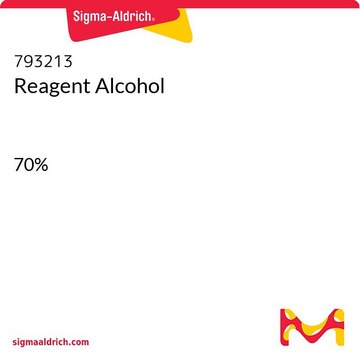187380
Ethyl alcohol, denatured
reagent grade
Synonym(s):
Ethanol
Sign Into View Organizational & Contract Pricing
All Photos(1)
About This Item
UNSPSC Code:
15101802
PubChem Substance ID:
grade:
denatured
reagent grade
reagent grade
Recommended Products
grade
denatured
reagent grade
Quality Level
form
liquid
contains
1% ethyl acetate as denaturant
1% hydrocarbons as denaturant
1% methyl isobutyl ketone as denaturant
5% methanol as denaturant
impurities
≤0.15% water
General description
Ethanol (denatured), a primary alcohol, is a constituent of hairspray, disinfectants and cosmetics. It can be synthesized either from molasses by fermentation or by hydration of ethylene. It is made non-consumable by the addition of denaturants.
The product is denatured ethyl alcohol and it contains following as denaturant:
- 1% ethyl acetate
- 1% hydrocarbons
- 1% methyl isobutyl ketone
- 5% methanol
Application
Ethyl alcohol (denatured ethanol) may be used to compose the Nital etchant for use in microstructural analysis.
signalword
Danger
hcodes
Hazard Classifications
Aquatic Chronic 3 - Carc. 2 Inhalation - Eye Irrit. 2 - Flam. Liq. 2 - STOT SE 2
target_organs
Eyes,Central nervous system
Storage Class
3 - Flammable liquids
wgk_germany
WGK 2
flash_point_f
48.2 °F - closed cup
flash_point_c
9 °C - closed cup
ppe
Eyeshields, Faceshields, Gloves, type ABEK (EN14387) respirator filter
Choose from one of the most recent versions:
Already Own This Product?
Find documentation for the products that you have recently purchased in the Document Library.
Customers Also Viewed
Spencer LT, et al.
Tissue processing 6." Bancroft's Theory and Practice of Histological Techniques, Expert Consult: Online and Print, 7: Bancroft's Theory and Practice of Histological Techniques, 107-107 (2013)
Voltammetric Analysis on the Formation of Fe (OH)2 and FeCO3, and on the Reactivity of Passivation of Steel in Carbonate Solutions.
Eliyan FF, et al.
Journal of Materials Engineering and Performance, 24(6), 2473-2480 (2015)
Selection of highly effective rectification regimes for ethyl alcohol.
Vyaz'mina NA and Baranov DA.
Chemical and Petroleum Engineering, 42(9), 494-502 (2006)
Surrogate alcohol: what do we know and where do we go?
Lachenmeier DW, et al.
Alcoholism, Clinical and Experimental Research, 31(10), 1613-1624 (2007)
Sodium hydroxide-catalyzed transfer hydrogenation of carbonyl compounds and nitroarenes using ethanol or isopropanol as both solvent and hydrogen donor.
Wang D, et al.
J. Mol. Catal. A: Chem., 400, 14-21 (2015)
Our team of scientists has experience in all areas of research including Life Science, Material Science, Chemical Synthesis, Chromatography, Analytical and many others.
Contact Technical Service




